| To incorporate a few old-school guitar building techniques is one thing -- for your company to sell more OM''s than anything else is another. Santa Cruz Guitars aren''t just old-school, they''re handcrafted by a small team that likes unsung woods and nitrocellulose. But Santa Cruz Guitars have a fresh, new vibe to them, not to mention a modern look, making them a popular choice for the most famous artists in the world, even though those artists have to pay for them - yet another old-school way of doing things that helps Santa Cruz stand out in today''s world of mass-produced instruments and endorsement-focused marketing. We had a chance to chat with Willie Carter, one of the company''s 20 employees, about the Santa Cruz shop, the guitars themselves and why the company does things the way it does. |
| To see videos of the Otis Taylor and Janis Ian models, click here. For our podcast talking with owner Richard Hoover, click here. |
We’re based on a lot of traditional building techniques, and of all the production shops this size, we’re the only one that really produces a hand-built guitar. We don’t have a lot of mechanized machinery like a lot of other shops. If you come to our shop, you’re going to see a lot of highly-skilled workers building our instruments and a lot of traditional techniques – dovetail joint as opposed to a bolt-on neck, which are a lot of people are using; nitrocellulose lacquer finish as opposed to polyurethane that most people are going to now.
We think [nitro] is tonally better and visually we prefer it as well. It’s a little more difficult to work with, but I think the overall results are better. And it’s traditional, which is what we think guitar making is about. You blend those traditional techniques with some of the modern techniques as well. We think you need to find a happy balance of both to give people the guitars they’re looking for.
It’s interesting because even with more and more people, nobody is doing what we do, and we’re busier than we’ve ever been. And we’re finding that we’re building more and more of the custom instruments and more and more of the high end instruments than ever before.
Let’s talk about this nitro issue for a minute. A lot of players swear that’s the finish for tone, but others worry about checking problems during travel. How do you justify the decision to go with Nitro?
Well, [checking] can happen, but the nice thing about a nitro as opposed to a poly is that it’s much easier to repair. With a poly, if you do have a crack in the finish or something like that, it’s very difficult to repair without being visible, where as lacquer is much easier to repair. It doesn’t require a lot of chemicals or machinery to repair it properly.
What are the tonal benefits to nitro?
We’re able to spray it much thinner than a lot of people are spraying the poly. And it’s more flexible, so if you have a lightly built guitar like we do, we don’t want to kill the tone by putting a thick plastic finish on it.
Let’s talk about your product line – you have a pretty wide range of sizes, what seems to be the most popular?
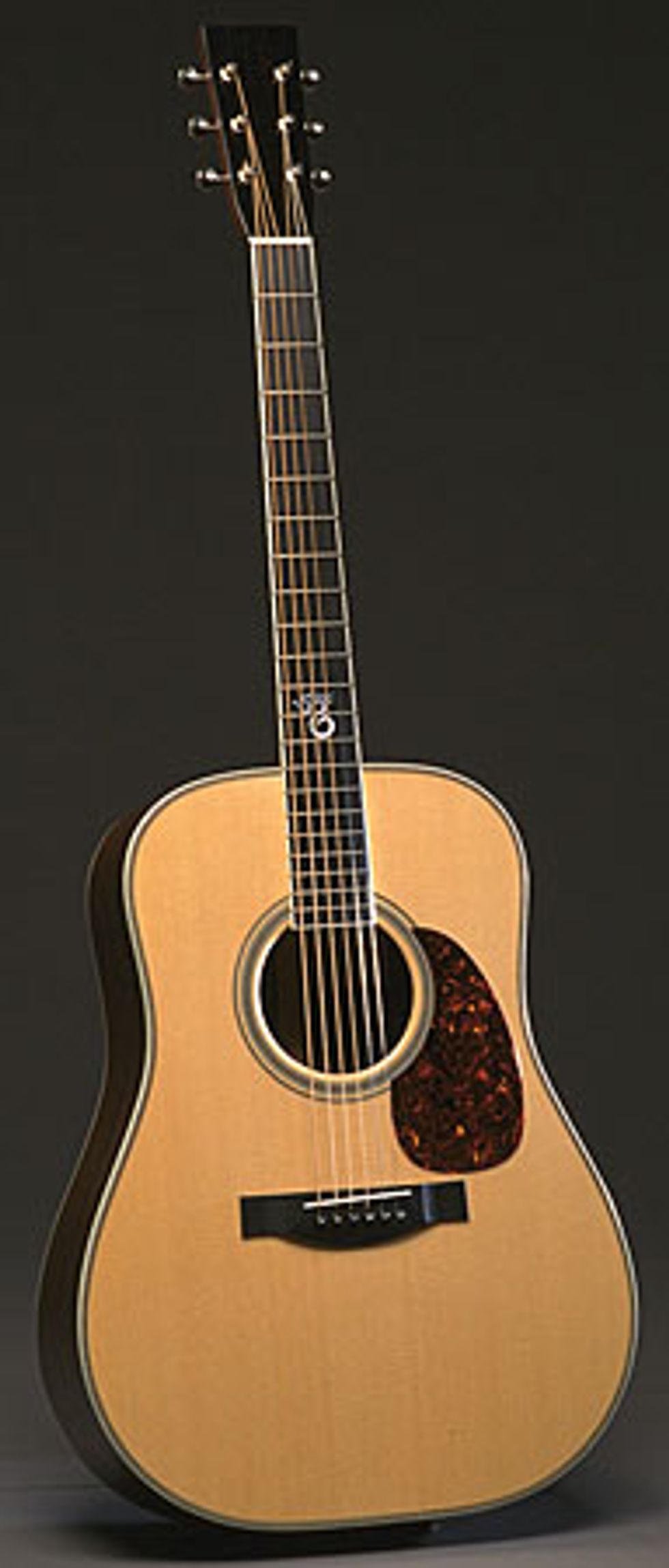 Santa Cruz Tony Rice model; the Tony Rice Professional model is also available |
We’re really fortunate to have a lot of great players playing our instruments. Many of the players you see on TV playing other peoples’ guitars take ours into the studio. So often what you hear in recordings are Santa Cruz guitars, especially in Nashville. There are a lot of great players using our instruments.
For a long time, the masses were into the bigger hips – the 45 or the 28 style acoustics. But we’re seeing more players and other companies going back to the aughts and the OM. Why is it that you guys gravitate toward them?
Well, I personally like the sound of the smaller guitars. Tonally, I think they are sweeter and much more balanced than the big treble strings. Which always seems to be a plus for recording – it’s much easier to mic that way.
And yes, we’ve seen a trend going back to the smaller guitars. As a matter of fact, we have a fairly new model, the Firefly, which is close to a 3/4 size guitar, that we just can’t make enough of. It’s really taken off. Several players in Nashville are using those to record with now because they’re easy, very round, and they sound great mic’ed up. We’re seeing a huge trend going back to the smaller guitars, the OOs, the OOOs, and the OM much more so than we’ve seen in the past.
In the American way, bigger is better – the Cadillacs and limousines – and the dreadnought was traditionally a huge seller. Martin still probably has a great portion of their sales in Dreadnoughts. We still make quite a few, the Tony Rice is always popular for example, but we’re finding that the OM size and smaller are becoming a higher percentage of what we’re producing. The OM has always been our #1 model, so that’s of no surprise to us at this point, but the smaller models are starting to take a larger percentage of our production.
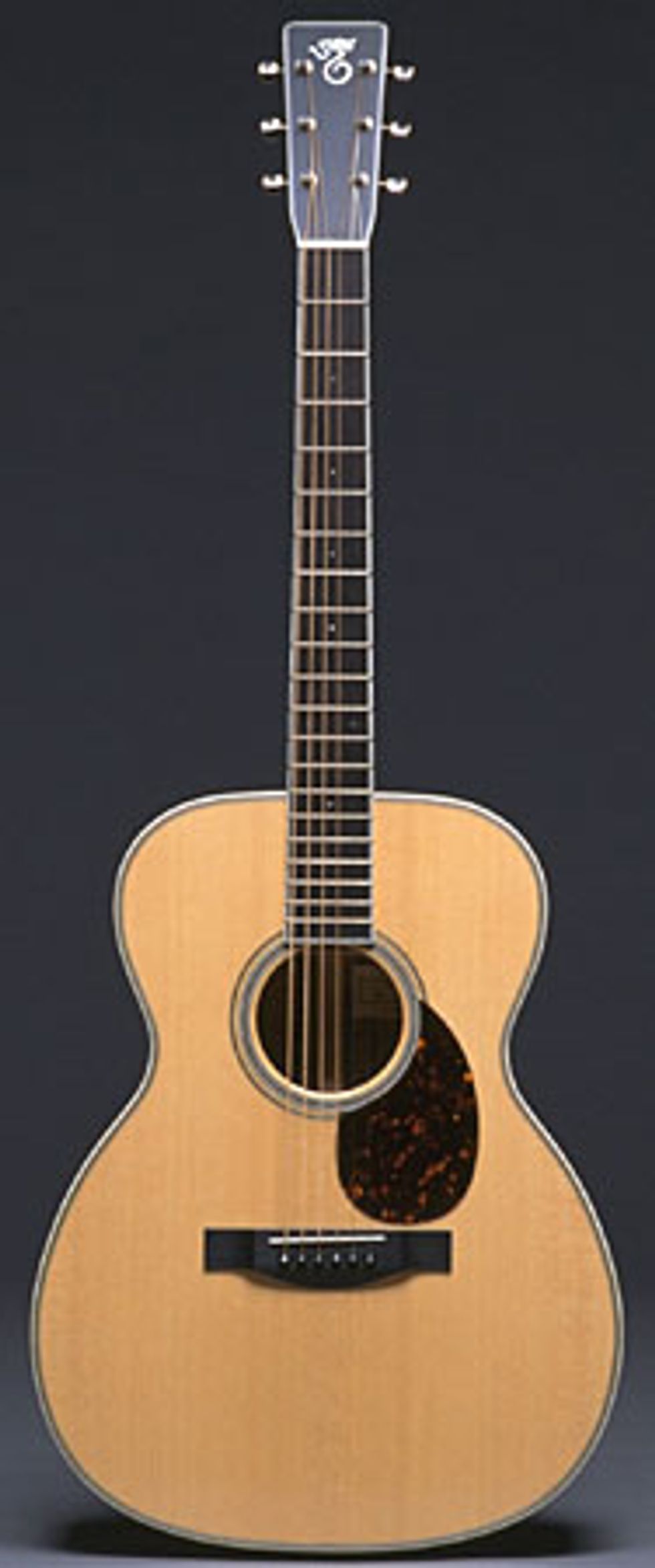 A Santa Cruz OM model |
I think what we find is because of our style of building. People like to find a guitar with some presence and some bass, and there are several dreadnoughts on the market that don’t have the same amount, compared to our OM. People are often surprised – they come in thinking they’re looking for a dread and they play one of our OMs and are blown away.
It’s a much more comfortable body for a lot of people too. Especially as we get older, sitting on the sofa, it alleviates some shoulder problems people get with a larger guitar.
Santa Cruz utilizes what’s referred to as a bench style of building, reviewing the work of the person before you. How does that work?
Well, we rotate people throughout the shop, but each person has their specialty. So there’s generally one guy that carve the tops, then he passes that on to the next person who’s putting the boxes together. People inspect their own work and the guy after them will inspect their work and send it back if need be. It’s a real team effort.
We have a group of fourteen people back there and that really keeps our quality level up and our consistency up because people really care about what they’re doing. It’s just as important to inspect your own work as it is to inspect somebody else’s work, and the final results speak for themselves in that, I think.
How much is handmade? Are there CNCs involved with certain wood shaping processes?
We have one CNC machine. The lay work is done on that, the bridges and the fretboards are done on that. Most of the necks are still carved. We try to do some of the repetitive things like that on the machine. We’re not as efficient with it as some of the other shops are, where the machine does a huge percentage of the work. We really feel that having the human hand involved makes a world of difference in this whole industry.
You guys offer both Brazilian and Indian rosewood. Obviously Brazilian is hard to find and can be prohibitively expensive - what are the differences for someone comparing the two?
Initially, the first thing you notice is that visually the Brazilian is typically much flashier, prettier wood, much more dense than the Indian. And [Indian rosewood] came about as a replacement for Brazilian wood when it became more difficult to obtain, and it’s a very nice tone wood, I’m not one to believe that one’s better than the other. They are different in density. The Brazilian tends to have more clarity, we find that they tend to be punchier instruments.
Obviously the difficulty in obtaining the wood affects the price, so Brazilian is much more expensive than Indian, but we do see that there’s a definite difference in tone between the two. But it depends on the player and what the player likes; some people love maple, some people love mahogany, some people love Brazilian, some people love Indian. And I think they’re all valid, it depends what you’re doing with it. A lot of it’s like cooking, you can have the same recipe and give it to ten chefs and it’s going to turn out different. People say that they don’t like a certain wood, so I always try to get them to play one of our guitars and see because it’s going to be different than someone else’s guitar with the same wood.
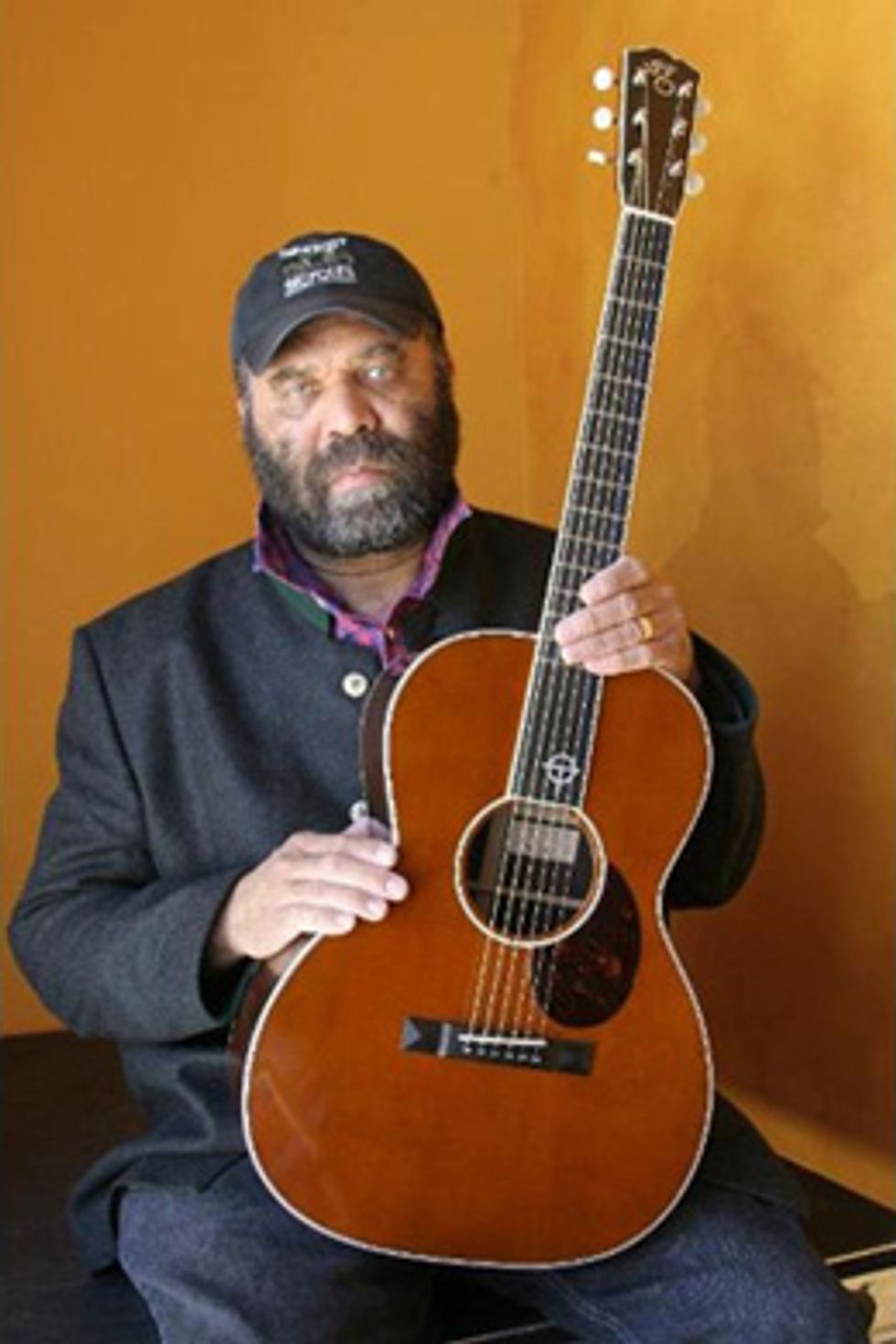 Otis Taylor and his cedar-topped signature model |
There is, again it goes back to what the builder does with the wood more so than anything else, but there are differences. You find that the overtone structure and the clarity are different. I think that the vast majority of guitars we’ve played in our lives have been Sitka tops, and you can make an incredible guitar with that if you know what you’re doing.
You guys do some cool stuff with cedar too. Is that kind of an unsung wood?
I think it is, as a matter of fact, yesterday I had a good conversation with a gentleman in Tennessee about that. There’s this fallacy that cedar fails and the guitar won’t last, but there are guitars that are decades old with cedar that are still together, it’s a matter of somebody working the wood properly, and thickness, and good quality wood. We’re very adamant about keeping it old-growth timber and aged wood, so we’re really selective on the woods that we use. We have the luxury because we’re not building 400 guitars per day, we build fewer than 800 in a year, so we can pick the best of the best for our guitars.
Did you say 800 per year?
Yeah, 800 or less. It varies between 750 and 800. It depends on our production and the types of guitars that we’re building throughout the year. It allows us to be more selective in the materials that we choose as opposed to a factory that’s building 400 or 500 guitars in a day.
How and where do you get your wood?
There are several sources. Some of it’s been here for years – the business has been around for over 30 years. There are wood vendors just like there are parts vendors for any other industry. Most of us builders share the same, but some of us have our secret sources. It’s part of the guitar industry, finding your secret source of wood, and any builder you talk to has that. Some of them we share in common, some of them we don’t.
One thing that’s unusual about Santa Cruz is we really try to use a lot of repeat timber. At one point all of our spruce was coming from old bridge pilings. We’ve pretty much gone through most of that, but we’re really responsible in where we source our woods. We recently started using Madagascar rosewood which is exclusively used on the Otis Taylor model at the moment, but it was a wood that Richard [Hoover, owner of Santa Cruz] was initially just not comfortable using because he was concerned about how it was harvested. We finally found a source that we felt comfortable with, so this year’s the first time we’ve offered that wood.
You have a really impressive list of people who play your guitars, but that isn''t an endorsement list, correct?
Well, one difference between us and a lot of the other companies is that we don’t give guitars away. If you see somebody playing one of our guitars it’s because they actually love it. We think that’s much more credible than giving a guitar to big name and putting up an ad. Our most recent ad campaign is focused on actually playing arts people who have purchased our guitars and are playing them. Some of the names you’ll know, some of them you won’t, but they’re all people who make a living playing their music. They’re supporting us and we try to support them with our guitars, and even Tony Rice, as long as he’s been with us, has paid for ever guitar he’s had. We also have an artist arrangement, but they have to make a sacrifice, because they choose us over some other guitars that they can get for free.
The list includes players like Eric Clapton, John Mayer, Dave Matthews...
There are a lot of well known artist who have endorsements with much larger companies than us, who actually have several of our guitars, but you won’t ever see them in public because they’re contracted, but a lot of the recordings are recorded with our guitars.
Can you let any of those names slip for us?
One of the busier session players in Nashville, Mark S. Stevens is one. A name that comes up the most is probably Garth Brooks. He uses our guitars exclusively -- and this is a guy who''s offered guitars every day. He''s actually been playing the Firefly most recently.
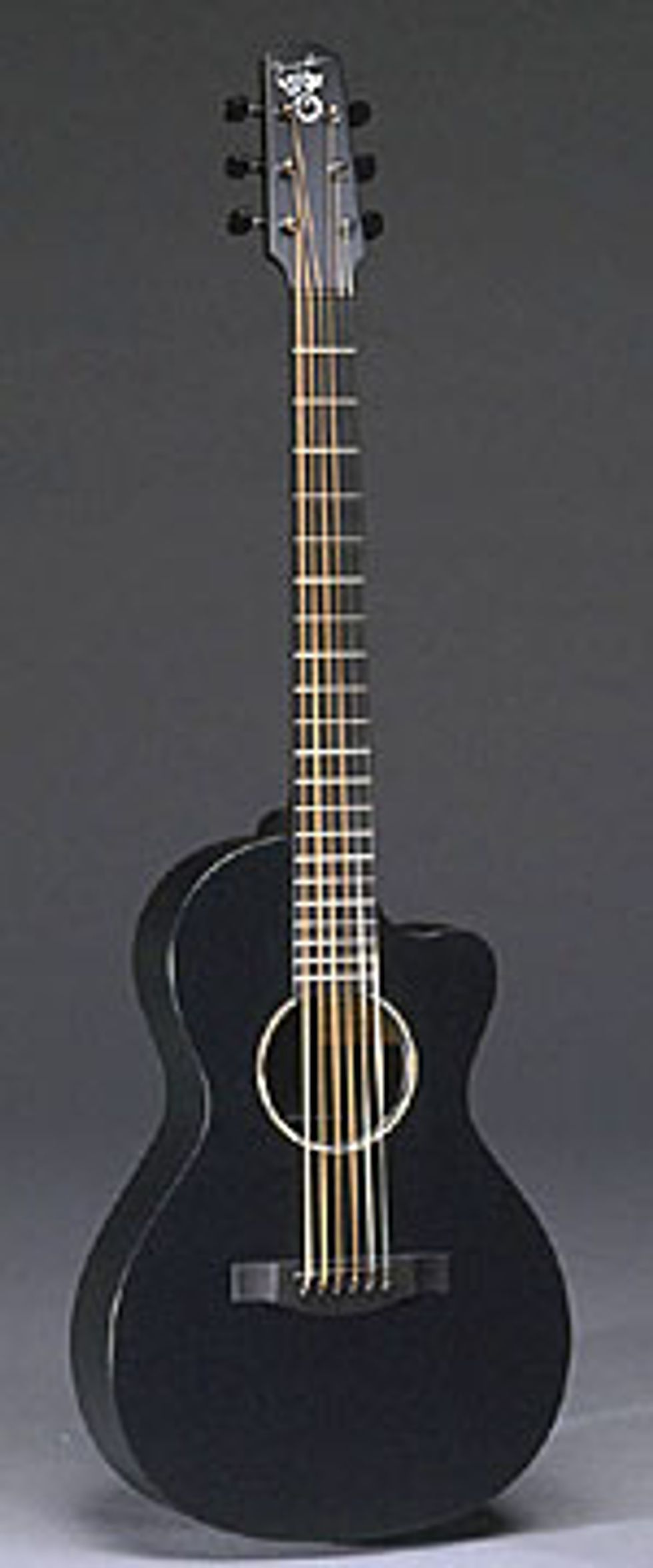 Janis Ian''s original black signature model |
Well Janis Ian has been around for a lot of years, and she stepped away, but she called us up a few months back and wanted to come back and join the family again, so we’ve revived her signature model, and revised it in quite a few ways. It’s no longer a black guitar, as she says, she’s out of her black stage.
Otis Taylor is a player who’s getting more and more press -- this is kind of a breakthrough year for him -- but he’s traditionally played archtops, along with banjo and mandolin and electric guitar. We got together with him and created a signature model for him that’s quite unusual in a number of ways, and so he’s set his archtops down and is using that exclusively on stage now. And his next recording that will be out in June 2009 is exclusively Santa Cruz guitar as far as acoustic guitar is on the album.
Arlen Roth is one of those guys who’s played with everybody and is not necessarily a household name for everybody, but us players know who he is and really enjoy what he does, and he’s a big fan of Santa Cruz guitars -- practically a walking billboard for us.
You guys tune your tops by hand. What is involved with that?
Well, one thing that you see if you go to most factories, is they’ll thickness each top to the same dimensions, often times their brace dock is dimensioned on their CNC machine and they glue them together. Somewhat like a model airplane kit, the parts are already cut up and they just glue them together. Whereas our brace dock is raw and each top is thicknessed depending on the characteristics of that top because each tree is different and each piece of wood is different. Some are stiffer than others and some are more flexible, so we treat each piece individually. We do the same with the carving of the bracing; a lot of it depends on the characteristics of that particular top. By doing it by hand, we have that kind of control, that flexibility to make each individual guitar the ultimate for that piece of wood.
Most production shops want something that eliminates the skill level of the employees, so it’s just a matter of having somebody there doing a task - we’re creating a situation that requires a higher level of skill and it makes it more fun for the people who are building the guitars because their souls are in it. It’s not so much a drudgery job, gluing things together. It’s very different, and it''s evident when you step in the shop.
What direction do you take for the bracing on your guitars?
Well we have a number of different bracing patterns. They’re all X-braced guitars, which Martin pioneered years ago and we just defined it. Most of our guitars are probably more in line with what Martin used to do in their earlier years, much lighter and more resonant, that kind of responsiveness that people crave in those old guitars, but that they may not be getting in some the newer guitars. When you start making that many guitars a day, you start to build heavier because you’re more worried about warranty concerns. If you get a Ford Escort or a Lamborghini, both of them will get you where you’re going, but the experience is going to be very different in that Lamborghini, and that’s what we’re shooting for, that high performance musical instrument.
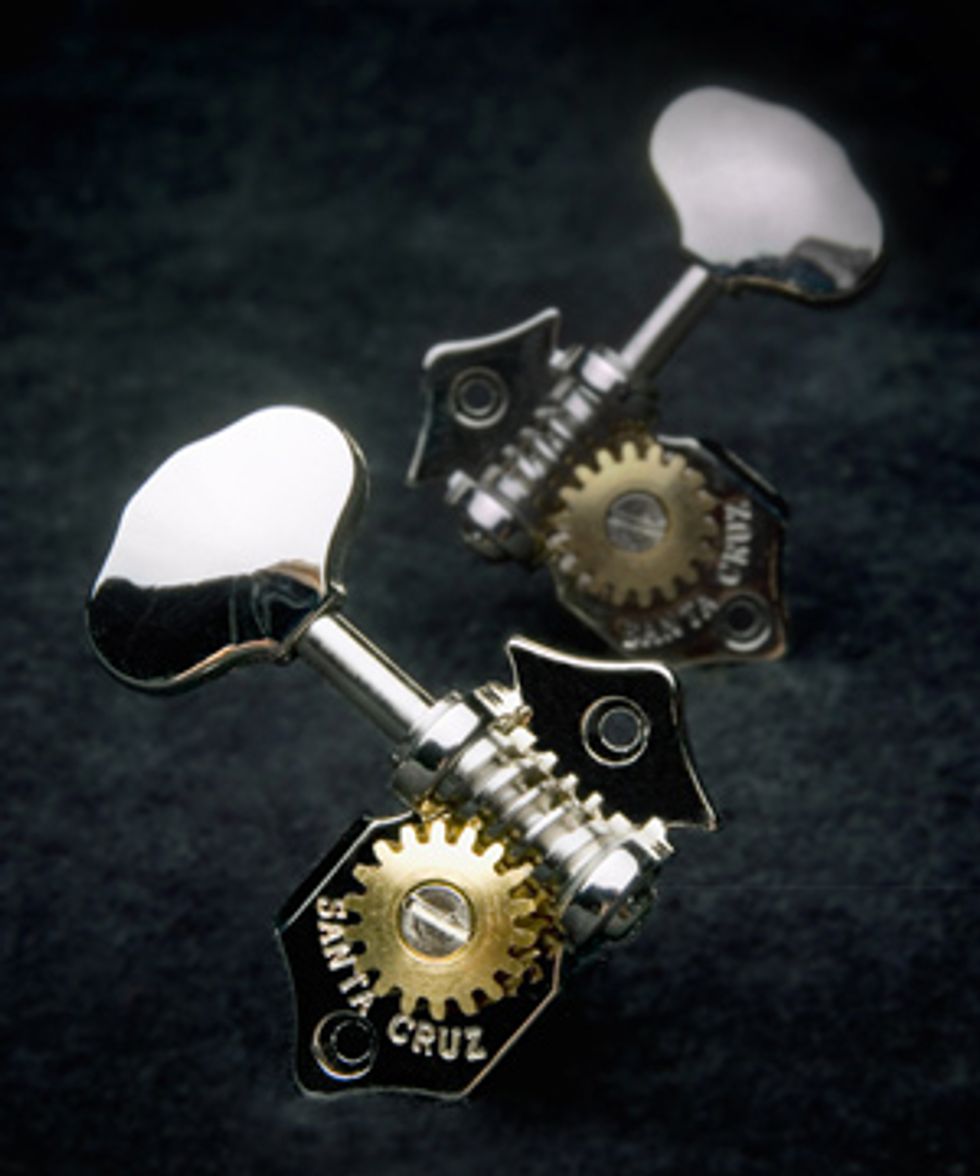 Santa Cruz second generation tuners |
Our tuners were designed by Richard and Dan, our production manager. We used to use the Waverlys like everybody else does, but we wanted something with a higher gear ratio, so we took a number of years for writing a second generation of our own. The first generation had some failures, so we went back to the drawing board to find it, and now they’re as good as anything else on the market plus they have our name on them, which we like. We can keep things in house and we have some control over the quality and we can serve the user better that way as well. We’re not so dependent on a certain supplier that services other people as well.
Do you offer electronics in the guitars?
We have a handful of guitars that come with electronics standard, but we pretty much install what people want. Most recently we’ve been using the L.R. Baggs and some B-band in the Otis Taylor guitars, the AER pickup which is a fairly good product itself, it sounds great, we’re really excited about that one.
With all of the custom orders, how far out of the norm do you go?
As I mentioned earlier, probably more than half of what we do is custom. We have that flexibility. People will request different scale lenghts, the most common is different kinds of inlays, bridge spacing, materials -- it’s all over the board. We’ll do different headstocks on guitars that we normally wouldn’t do. It’s kind of crazy, we leave it to your imagination and it’s very rare that we say no to something.
What’s around the corner for you guys?
Well, one new thing that we’re offering is traditional hot hide glue and Adirondack bracing on our guitars. It’s an option that we have on a couple of models that aren’t standard, the Otis Taylor being one of those. It consists of Adirondack brace dock for the bracing, which is a little stiffer brace dock than we usually use and traditional hot hide glue to glue the bridge, the neck joint and the bracing. We’re finding that it seems to make a more powerful, clearer sounding guitar, so we’re real happy with that.
Well, one new thing that we’re offering is traditional hot hide glue and Adirondack bracing on our guitars. It’s an option that we have on a couple of models that aren’t standard, the Otis Taylor being one of those. It consists of Adirondack brace dock for the bracing, which is a little stiffer brace dock than we usually use and traditional hot hide glue to glue the bridge, the neck joint and the bracing. We’re finding that it seems to make a more powerful, clearer sounding guitar, so we’re real happy with that.
All those pre-war Martins and Gibsons that people crave, they were originally made with hot hide glue. It tends to dry harder than the more modern glue, so the wood tends to resonate more. Modern glues can almost be like putting a sponge between the pieces of wood sometimes, obviously not that flexible, but those glues don’t dry as hard and tend to be a little bit more rubbery. So for the best transfer of vibration, we find that using the glue that dries harder, the guitars to tend to be better.
We have all kinds of different things in the works as far as different models or variations. We’re probably the most flexible production shop of our size as far as custom work goes; I’d say over 50 percent of what we build are custom instruments. People get really excited about it because the sky’s the limit as far as what their dreams are, and we can pretty much do it. That’s the beauty of us being a hand builder as opposed to having twenty CNC machines doing everything -- we have much more flexibility to refine an instrument to a player’s needs.
We have all kinds of different things in the works as far as different models or variations. We’re probably the most flexible production shop of our size as far as custom work goes; I’d say over 50 percent of what we build are custom instruments. People get really excited about it because the sky’s the limit as far as what their dreams are, and we can pretty much do it. That’s the beauty of us being a hand builder as opposed to having twenty CNC machines doing everything -- we have much more flexibility to refine an instrument to a player’s needs.
For more information:









![Rig Rundown: Russian Circles’ Mike Sullivan [2025]](https://www.premierguitar.com/media-library/youtube.jpg?id=62303631&width=1245&height=700&quality=70&coordinates=0%2C0%2C0%2C0)








